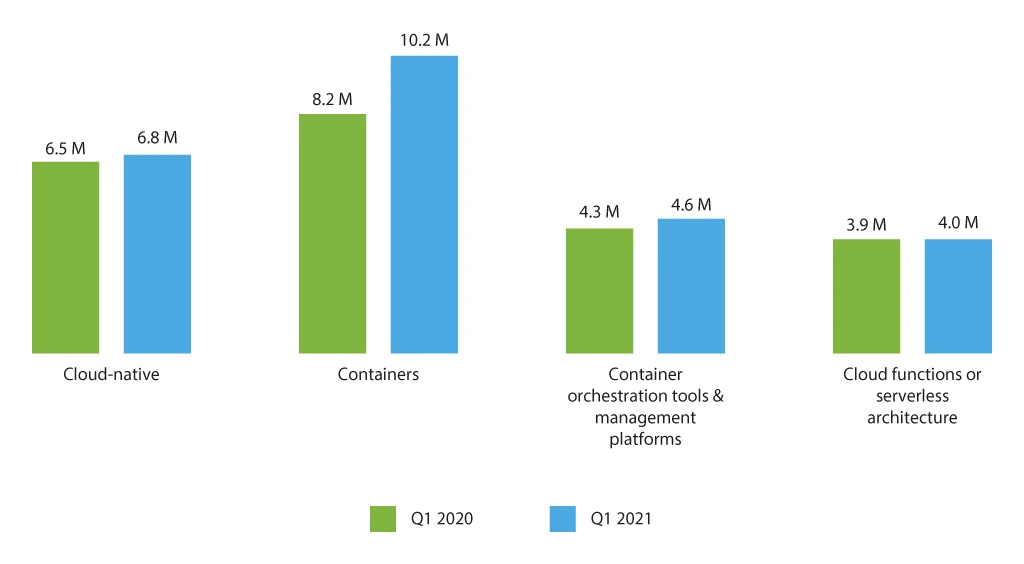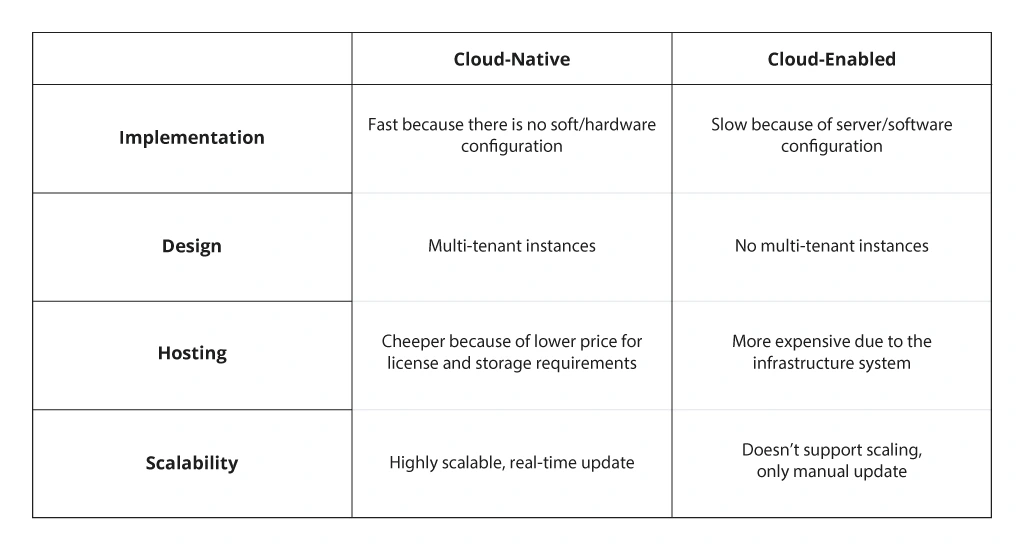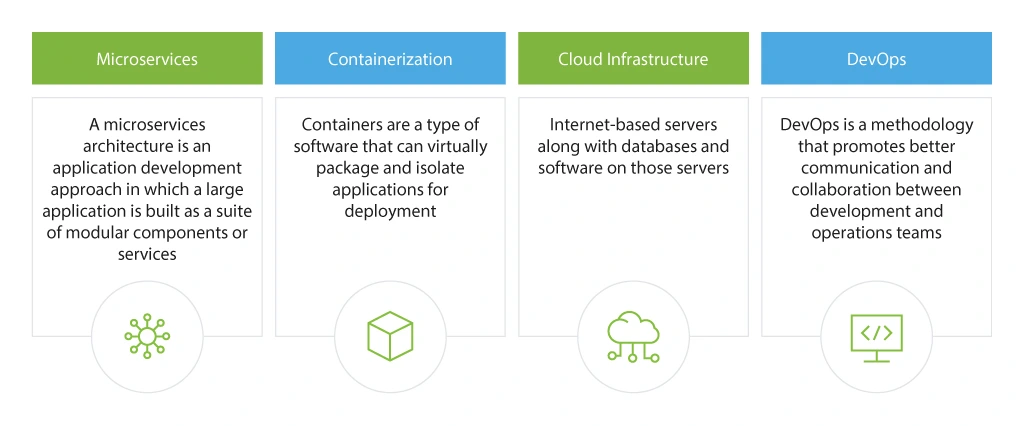7 Reasons to Choose Cloud-Native Solutions over Anything Else
Yearly dynamics show that the cloud-native developer community surged from 6.5 million to 6.8 million engineers from FY20Q1 to FY21Q1, adding 4.6% during the 12-month period. So did the popularity of containers, their orchestration instruments, and serverless architecture, as the study of cloud-native development shows.
The Cloud-Native Developer Population Growth
Introduction to Cloud-Native
Whether it is public, private, or hybrid cloud, cloud-native technologies offer businesses a different approach to creating and running applications virtually. The latter are made with scalability in mind.
Unlike conventional applications with a monolithic architecture, cloud native apps harness the potential of separate microservices running in cloud ecosystems.
The pioneers to go down this road were a cohort of well-known companies nowadays called ‘born in the cloud’. These are renowned businesses like Uber, Netflix, and AirBnB, whose IT assets took roots in the cloud and have been there ever since.
In addition to these trailblazers, companies who opted for a shift to virtual environments emerged, transforming their assets into cloud-based apps. Let us take a moment and cover an important difference between the two types of applications.
Cloud-native and cloud-based are distinct kinds of apps that differ in terms of development practices, performance, and other key components.
The main difference between the types narrows down to the initial purpose of the technology. On the one hand, cloud-native applications are made to reside in the cloud. On the other hand, cloud-enabled solutions are architectured for deployment in traditional data centers.
A cloud-based application is an existing app shifted to a cloud ecosystem. In such a scenario, its local blocks and cloud-based ones will work together. Usually, this is the destiny of outdated enterprise and legacy software that require system modernization.
Overall, cloud-native applications are quick to implement since there is no need for hardware and software configuration. In addition, hosting expenses are lower because of cheaper licensing and storage. An apple-to-apple comparison suggests differentiating the two types of applications by implementation mode, design, hosting, and scalability options:
What is Cloud-Native Architecture
Usually, cloud-native app development includes cloud platforms, microservices, cloud platforms, lightweight containers, APIs, CI/CD, Kubernetes, and strong DevOps culture. In a nutshell, cloud-native development relies on 4 major pillars:
When it comes to cloud-native architecture, an application code is designed, built, and delivered very differently than it would be for conventional monolithic architecture. The end benefit of such a distinction for any business is fostered innovation and operational agility.
The limitless power of cloud computing is put to work 100% when building and running cloud-native applications, with each component having a certain role and advantage:
- Microservices architecture: each app is a combo of small services that can be operated separately from each other. Thus, each service belongs to a certain development team that has a chance to work at its own pace to create, deploy and scale a particular service.
- The apps are packaged in containers that offer much-needed isolation for microservices; highly accessible, scalable, easily portable from one environment to another, containers for cloud-native solutions are fast to create or scrap, making them an ideal ‘wrap’ for building and running microservices.
- Cloud infrastructure consists of hardware and software parts, including storage, virtualization software, services, servers, networking, and orchestration tools that enable a cloud computing model. One more component is application programming interfaces and API-enabled command-line.
- The DevOps component in cloud-native application development allows for rapid, frequent, and consistent software development. With development and operations squads tightly knit, businesses benefit from a quicker release of updates. With no impact on end-users, engineering teams work each on their own part of the functionality.
Put all together, this results in resilience in cloud-native application development, taking productivity to a whole other level while simplifying business operations at the same time.
Benefits of the Cloud-Native Model
With cloud-native development, updates and new functionality can be pushed live whenever a new feature is ready with no disruption to app performance. Scaling up or down becomes quick, allowing businesses to better utilize resources and tap into customer needs in the blink of an eye.
Beyond that, replacing failed components and recovering from unexpected events happen faster, minimizing or eliminating service downtime.
According to Capgemini, the speed enabled by cloud solutions is the most important advantage of cloud-native tools. Moreover, the development of cloud-based applications is cost efficient. To top it off, superior CX comes into play, allowing businesses to create a competitive edge.
The following are some pivotal points of cloud-native benefits:
1. Reduced Time to Market
Quicker time to market is one of the top goals for numerous businesses. Reducing the time necessary to roll out a product offers a competitive advantage. The latter, in turn, allows businesses to embrace the current trends in pursuit of a greater market slice. As per an IBM study, more than 70% of development managers, IT executives, and developers confirmed that cloud-native principles resulted in faster development and launch.
Case in point
Using Kubernetes, the U.S. Department of Defense reduced the time of its releases from 3-8 months to a week. The department ripped the benefits of cloud-native security and system velocity after the upgrade. With total time savings of 100+ years across 37 programs, the project powered DevSecOps on F-16s and large armored warships.
2. Ease of Management
Cloud-native services enable straightforward infrastructure management. Using serverless platforms does not require configuring on-premises networking, planning for storage, and provisioning cloud instances.
With the growing popularity of cloud-native platforms and thus, access to the offered infrastructure, the concept of Infrastructure as Code (IaC) flourished.
In such a way, companies can reduce the time for infrastructure set-up and better utilize existing human resources that would otherwise be spent on manual IT infrastructure management.
Case in point
Cloud-native solution transformed the way of doing business for an online video streaming service Mux, whose workflows had many moving components. To juggle such a setting, the company utilized Docker containers at the start, using the Rancher stack for orchestration. However, it experienced stability issues related to networking. Thus, it switched to Kubernetes to fuel productivity in management and version deployments.
3. Reduced Costs
The majority of businesses spent around 80% of their IT budget to support the existing infrastructure instead of investing in organizational development. At the same time, about 30% of data center capacity is generally not used. Cloud-native computing offers an organization another path and approach to infrastructure, shifting its budgets from expensive ecosystems working non-stop and channeling those savings into new functionality roll-out.
Case in point
Smart Cards decided to implement a reliable cloud solution as a part of its digital transition journey. Using DevOps best practices, extensive knowledge of Docker containers and Kubernetes, Infopulse created a custom-built cloud solution, helping the client with automated software delivery and speed up time to market. The project brought a French software and hi-tech production company 80,000 EUR of savings.
4. Reliable Systems and Reduced Downtime
Built with resilience in mind, cloud-native security is enhanced because such apps are designed along with security professionals on board. In case of a cyber-attack, a business has more chances to efficiently deal with the aftermath of a breach within a certain container while the remaining parts of the app are unaffected.
The key enabler of such an isolated threat management is the container orchestrator. Furthermore, when some area of infrastructure goes down or a particular data center experiences issues, the portability of cloud-native software helps developers shift a component to an alternative environment within the cloud that is up.
Case in point
HubSpot scaled tremendously after it doubled production load and number of databases without any changes made to team headcount. Willing to build upon existing MySQL operational knowledge, a top-tier CRM platform opted for Kubernetes adoption that allowed it to quickly update databases that used to take days before. After automation, the downtime due to system crashes only lasts seconds.
5. No Vendor Lock-in
Sometimes 3rd party service providers choose to make an upgrade or changes to their policies without you agreeing to any updates. However, the situation is not a problem for cloud-native software. The businesses choosing cloud can shift to a different support vendor to leverage their cloud-native services and solutions. To top it off, they are free to use any other community software that allows for the desired integrations.
Case in point
A Czech FinTech company serving Forex brokers and their global clients had to migrate all of their microservices from the PaaS provider solution to Docker containers and Kubernetes (EKS) after their provider announced that it would be changing its service prices within a quarter. The software vendor they chose to help with the changes integrated CI/CD to their new Kubernetes-powered platform on AWS, utilizing their CircleCI pipeline and GitHub. The transformation lasted less than 3 months, helping the FinTech business to avoid a vendor lock-in.
6. Scalability and Flexibility
According to the IMB’s survey, 75% of respondents admit they enjoy enhanced flexibility to make improvements in real-time using a cloud-native model. Making ad-hoc performance changes with cloud-native approach offers businesses more chances to tap into and satisfy their customers’ evolving demands.
Case in point
Slack solved the problem of manually dealing with its hosts, operating the legacy configuration that was no longer coping with the growing number of MySQL queries per second. The company chose Vitess clustering system that allowed it to keep working with MySQL and hosting its own instances using AWS. The project enabled the company to handle about 500,000 queries per second at peak and lower the connection latency to 1 millisecond in general.
7. Improved Customer Experience
Perhaps unsurprisingly, companies that can offer solutions that reflect their customer evolving demands faster are going to ride the wave. These businesses are likely to attract and retain the crème of the crop clients, who would appreciate such a customer-centric experience. Cloud-native tools give green light to continuous delivery, enabling engineers to offer software and app updates in short ongoing cycles.
Case in point
InfluxData was looking for a multi-cloud and multi-region strategy that would speed up its product and service delivery. The challenge was to figure out how to do it without having to maintain separate applications to embrace the particular characteristics of every cloud provider. As a result of its quest, the company chose Kubernetes to build a true cloud abstraction layer that enabled the frictionless delivery of database as a single application to all three major cloud providers: AWS, Google Cloud, and Microsoft Azure across all the global clusters.
To Conclude
Taking into account all the advantages of cloud-native development, it is high time to think of embracing a new way of designing and building your apps. No doubt, it is better to start an upgrade with a reliable vendor’s guidance.
If you have some knowledge gaps or lack in-house expertise, we can help you get started with the transformation journey.
![Reasons to Choose Cloud-Native Development [banner]](https://www.infopulse.com/uploads/media/7-reasons-to-choose-cloud-native-solutions-over-anything-else-1920x528.webp)




![Cloud-Native for Banking [thumbnail]](/uploads/media/cloud-native-solutions-for-banking_280x222.webp)
![Generative AI and Power BI [thumbnail]](/uploads/media/thumbnail-280x222-generative-AI-and-Power-BI-a-powerful.webp)
![Cloud Native vs. Cloud Agnostic [thumbnail]](/uploads/media/thumbnail-280x222-cloud-agnostic-vs-cloud-native-architecture-which-approach-to-choose.webp)
![DevOps Adoption Challenges [thumbnail]](/uploads/media/thumbnail-280x222-7-devops-challenges-for-efficient-adoption.webp)
![Azure Monitor for SAP [thumbnail]](/uploads/media/thumbnail-280x222-azure-monitor-for-sap-solutions-an-overview.webp)

![Mortgages Module Flexcube [Thumbnail]](/uploads/media/thumbnail-280x222-Secrets-of-setting-up-a-mortgage-module-in-Oracle-FlexCube.webp)
![Digital Alignment Drivers [thumbnail]](/uploads/media/thumbnail-280x222-the-top-forces-driving-digital-alignment.webp)
![AWS vs. Azure Cloud Platform [Thumbnail]](/uploads/media/thumbnail-280x222-comparison-of-aws-vs-azure-when-each-cloud-platform-works-best.webp)
![Cloud-Native Maturity Model Assessment [thumbnail]](/uploads/media/thumbnail-280x222-what-Is-the-cloud-native-maturity-model-definition-and-assessment-criteria.webp)